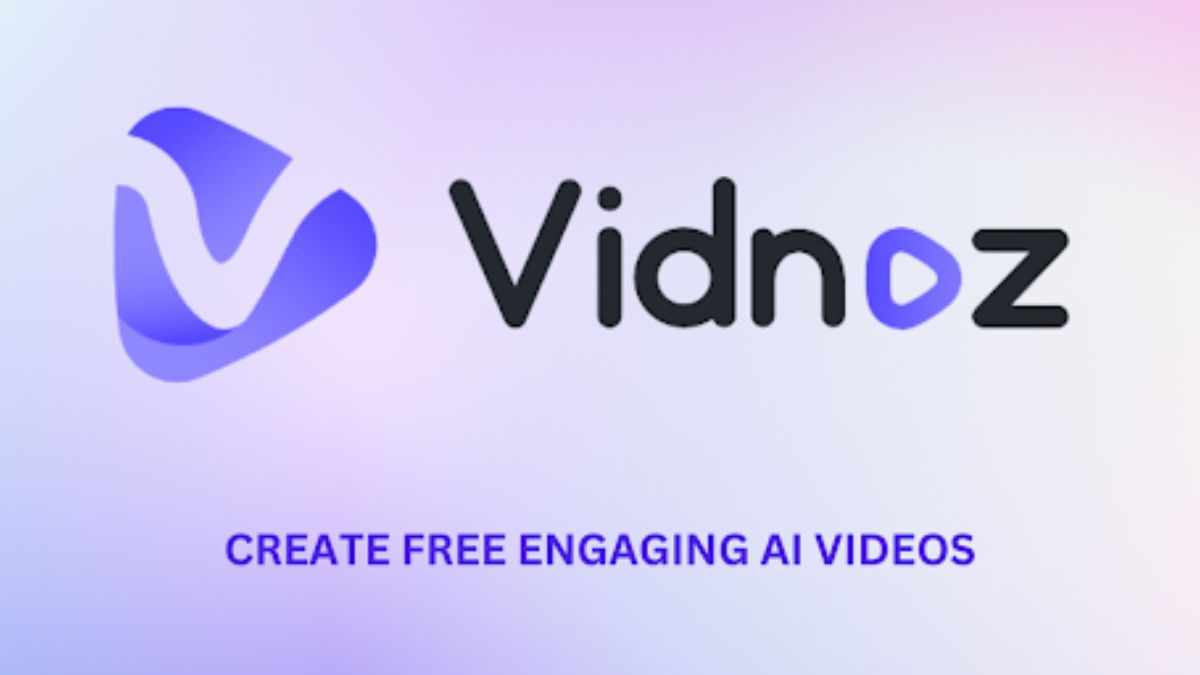DIGITAL MARKETING
The Rise of Free AI Tools: How Anyone Can Create and Translate Videos Like a Pro

Let’s face it: video content rules the internet. From TikTok clips to YouTube tutorials, we’re all consuming or creating videos like never before. But here’s the catch: making polished videos or adapting them for different languages requires serious skills, time, and money. Not anymore. Thanks to free AI tools, anyone with an idea and an internet connection can now produce professional-looking videos or translate them into multiple languages without breaking a sweat (or the bank).
I’ve spent weeks testing platforms that promise “AI magic,” two tools stood out: Vidnoz’s AI video generator free and their video language converter. Here’s why they’re game-changers for creators, educators, and small businesses and how you can use them to up your content game.
1. Free AI Video Generators: Your Shortcut to Stunning Content
How It Works (Without the Tech Jargon)
Picture this: You’ve got a killer idea for a YouTube video or an Instagram Reel. But instead of wrestling with editing software for hours, you type out your script, pick a template, and let AI do the heavy lifting. That’s exactly what Vidnoz’s AI video generator delivers.
You start by typing your script say, a 200-word explainer about baking sourdough bread. Then, choose a template: maybe a vibrant “Foodie” theme with upbeat music. The AI scans your text, splits it into scenes, and suggests visuals (like animated bread dough rising or close-ups of a golden crust). It even adds a voiceover using eerily realistic AI-generated voices. Ten minutes later, you’ve got a shareable video.
Why This Feels Like Cheating (In a Good Way)
- No More Blank Canvas Panic: Templates guide you, so you’re not staring at a timeline wondering where to start.
- Zero Budget Required: Free tools often slap watermarks on your work or limit exports. Not here.
- Speed: I tested this by making a 1-minute promo video for a friend’s Etsy shop. From script to final video? 12 minutes.
Who’s It For?
- Small Businesses: Turn product descriptions into demos.
- Teachers: Transform lesson plans into animated videos.
- Hobbyists: Share your passion projects without editing headaches.
💡 Pro Tip: Pair the AI-generated video with your own clips for a personalized touch. I dropped in a 5-second clip of my cat “reviewing” a cat toy, and it blended perfectly.
2. Video Language Converters: Speak Your Audience’s Language (Literally)
How It Works (Without the Headaches)
You’ve made an amazing video. But what if your audience speaks Spanish, Hindi, or Mandarin? Hiring translators or voice actors isn’t realistic for most of us. Enter Vidnoz’s video language converter online free tool that translates your video’s audio or subtitles into 20+ languages.
Upload your video, pick a target language (like Japanese), and let the AI transcribe, translate, and dub your video. The result? A new version where the AI voice matches the original tone. If you’re nervous about robotic voices, don’t be the voices here sound scarily human.
Real-World Example
A nonprofit I volunteer with used this to translate a fundraising video into French and Arabic. Donations from those regions jumped 30% in a week.
Why This Tool is a Secret Weapon
- Break the Algorithm Trap: Platforms like YouTube prioritize videos watched in full. If viewers bail because they don’t understand, your reach suffers. Translated videos keep them hooked.
- Repurpose Content Faster: Turn one YouTube video into 5 TikTok clips for different regions.
- Avoid Cringe Mistakes: The AI handles slang and idioms better than Google Translate (no more “chestnut” instead of “brown” in Spanish).
💡 Pro Tip: Use subtitles instead of dubbing for authenticity. I translated a cooking video into Italian with subtitles, and viewers loved that they could still hear my passion in the original audio.
3. Why These Tools Are Changing the Game
A few years ago, tools like these were reserved for companies with big budgets. Now, they’re free and user-friendly. Here’s what that means:
- Democratizing Creativity: A college student in Nairobi can compete with a corporate team in New York.
- Saving Time (and Sanity): Spend less time editing, and more time brainstorming ideas.
- Global Communities: Connect with people worldwide without language barriers.
4. 3 Pitfalls to Avoid (From Someone Who Learned the Hard Way)
AI tools are powerful, but they’re not mind-readers. Here’s how to dodge common mistakes:
- Garbage In, Garbage Out: If your script is messy, the video will be too. Keep sentences short and clear.
- Overdoing It: Just because you can add explosions to every scene doesn’t mean you should. Less is more.
- Skipping the Fine Print: Always check translations. The AI once turned “Let’s hit the gym!” into “Let’s attack the gym!” in German. Awkward.
5. The Future? It’s Already Here
AI isn’t replacing creativity it’s amplifying it. Imagine describing a scene (“sunset over mountains with a drone shot”) and the AI building it. Or translating live streams in real-time. Tools like Vidnoz are just the start.
Ready to Try It Yourself?
Whether you’re a podcaster wanting video clips, a marketer targeting global customers, or a grandma sharing family recipes, these tools remove the friction.
- Start with the free AI video generator to turn your ideas into visuals.
- Then, use the video language converter to share them with the world.
No tech skills required. No credit card is needed. Just creativity, a little curiosity, and maybe a cup of coffee.
DIGITAL MARKETING
Scaling Smart: How to Evolve Your Localization Strategy with Your Product

Detailed localization services give companies a significant advantage in crowded markets by delivering experiences tailored to cultural distinctions. Executing their localization strategy enhances their financial results by improving conversion rates and accelerating market entry.
Achieving success requires more than simply translating content. Effective localization requires adaptable systems that manage expansion seamlessly as their essential foundation. Measurable goals and clear KPIs enable stakeholders’ organization and allow teams to monitor their progress.
This article teaches product managers how to create a flexible localization strategy that expands alongside their product. It also teaches readers practical methods for expanding their localization efforts through process evaluation, team assembly, tool selection, and result tracking.
Current State of Your Localization Process
Product managers should thoroughly examine their existing localization processes to pinpoint strengths and improvement opportunities before expanding their localization approach. A systematic evaluation will establish an infrastructure for environmentally friendly growth while preserving quality standards throughout international markets.
1. Key components to assess
The effectiveness of localization services depends on multiple integrated factors. Product managers must examine their target markets and languages to learn about cultural priorities and purchasing behaviors. Website traffic metrics, customer satisfaction scores, and conversion rates, along with clear key performance indicators (KPIs), provide reliable success measurement methods.
Team structure makes processes more efficient. Successful localization requires four key groups: The successful localization process requires four fundamental teams, including software developers, project managers, content creators/translators, and quality assurance specialists. Centralizing localization efforts between marketing departments, web developers, product teams, and customer support staff enables significant cost reduction and quality enhancement.
2. Common bottlenecks to address
Recurring challenges frequently impede organizations’ localization workflows. Isolated teams produce significant bottlenecks because they lack adequate communication channels between various process stages. One primary cause of inefficiency occurs when developers, designers, and translators operate with different tools that fail to synchronize, causing scattered workflows and project delays.
Manual tasks create another major obstacle. Teams don’t deal very well with:
- Repetitive file preparation and content uploads.
- Time-consuming screenshot management for context.
- Inefficient review and validation processes.
When software contains hard-coded strings, technical constraints create delays in the workflow. Developers face increased complexity in localization because they need to update every text instance manually in the code.
Automation should be used to streamline organizational operations wherever applicable since repetitive tasks such as file handling and quality checks benefit significantly from this approach. A central system for managing content eliminates version control problems while maintaining uniformity throughout every localized material.
By systematically working through these components, product managers can establish an efficient localization process that facilitates their global expansion objectives. The strategy deployed ensures top-notch quality standards in every target market.
Building Your Scalable Foundation
Building a strong foundation is essential for scaling localization operations throughout worldwide markets. Product managers can establish flexible frameworks by building effective teams and selecting appropriate tools to handle increasing demands.
1. Setting up the right team structure
A centralized team structure with defined roles for everyone is essential for the proper localization strategy. The most effective teams include both internal specialists and external localization service providers. Your team needs to include a visionary leader, project managers, translators, localization engineers, and quality assurance specialists—defined roles for each team member to prevent delays in workflow processes.
2. Choosing localization tools that grow with you
Scalable localization depends on having the right technology stack as its essential component. Your Translation Management System (TMS) serves as your main coordination center and includes critical capabilities.
- Automated workflows that simplify task assignments.
- Quality assurance checks across 22 languages.
- Integration with Figma and development platforms.
- Cloud-based translation memory that maintains consistency.
3. Creating flexible workflows
Agile workflows enable teams to adjust their methods rapidly to match product development changes. Teams must embrace continuous localization approaches because traditional waterfall methods no longer suit modern development needs. This approach lets translation happen alongside development, enabling products to reach markets faster with simultaneous releases.
Teams can boost efficiency when they:
- Set up automated processes for routine tasks.
- Build clear documentation and guidelines.
- Create regular feedback loops with stakeholders.
Quality workflows handle increased volume smoothly. Teams that blend machine translation capabilities with human expertise maintain high standards during scaling operations. A unified source of truth alongside version control helps maintain content consistency during growth.
The combination of smart team-building practices, appropriate tool choices, and adaptable workflows establishes a robust localization foundation that enables growth. This approach enables organizations to preserve quality standards across multiple markets during their growth period.
Aligning Localization with Product Growth
The success of products in global markets requires synchronizing localization strategies with the products’ development phases. Studies demonstrate that 76% of consumers choose products with information available in their native language, making localization essential to entering new markets successfully.
1. Mapping localization needs to product stages.
Product managers must maintain revenue records from non-English-speaking markets. This helps them set their localization priorities. Applying this information will ensure that resources are effectively spread throughout all stages of product development.
As products expand, they must respond to different cultural norms. Localization means more than just translation. It covers:
- Cultural adaptation of content and functionality.
- Market-specific user interface modifications.
- Regional compliance requirements.
- Local news and content relevance.
2. Prioritizing markets based on product data
Market prioritization achieves optimal results through the support of essential metrics and market indicators. Product managers need to look at:
- Annual growth forecasts for individual countries.
- Current revenue percentage from each target market.
- Competitive landscape analysis in potential markets.
Thorough market research enables organizations to gain insights into cultural preferences and consumer patterns within their target regions. Understanding individual user preferences empowers the development of tailored experiences that draw users in and promote product adoption.
Content needs to reflect the cultural aspects of local users. Investing in culturally aware localization helps companies establish trust while preventing misunderstandings. Feedback from local users helps improve localized products through iterative testing and refinement.
Quality becomes vital during market expansion. Effective localization requires organizations to implement robust quality control checkpoints during all phases. The quality control checkpoints throughout localization processes involve linguistic review, functional testing, and user acceptance testing. Translators rely on detailed localization kits to achieve accurate meaning transmission because of the contextual information they provide.
Product managers establish adaptable strategies that boost worldwide growth through synchronized localization efforts at different product stages and data-driven market decisions.
Measuring Success and Scaling Impact
Product managers require appropriate metrics to enhance the effectiveness of their localization initiatives. Recent studies reveal that 96% of businesses experience positive returns through localization investments, while 65% achieve triple or more ROI.
1. Essential metrics to track
Product managers can evaluate their localization effectiveness by using these specific performance indicators.
- Translation Quality: Close monitoring of quality rates and error frequencies ensures high-standard maintenance. Product managers need to use standardized evaluation tools, such as MQM, for objective quality assessments.
- Turnaround Time: The duration of project completion from beginning to end reveals essential insights. The provided information allows teams to identify workflow disruptions and refine their processes.
- Cost Efficiency: Analyzing spending patterns based on language and market helps supply chain managers predict accurate resource requirements. Ideal resource management requires teams to measure cost efficiency by word tracking to remain within budget constraints.
- Customer Satisfaction: CSAT surveys provide insights into the reactions of target audiences toward localized products. Their feedback directly shapes future localization strategies.
2. Using data to guide expansion
The scaling success requires ongoing analysis and monitoring of performance data. Product managers can use advanced analytics to:
- Optimize Costs: Analyzing words processed by the project and provider enables the identification of cost-saving opportunities.
- Improve Workflows: The use of delivery times and average job duration metrics aids organizations in streamlining their processes.
- Control Quality: Performance differences across language pairs are revealed by Language Quality Assessment scores in each category.
Product managers find clear starting points through Google Analytics reports and attribution modeling. They can calculate value by comparing the initial investment with the revenue from localized products.
Numbers reveal powerful narratives that influence organizational results. Self-service reporting tools enable companies to identify market trends that inform their expansion strategies and resource allocation decisions.
Localization services maintain their strength while handling greater volume. This process’s scalable nature ensures consistent output regardless of project size. Product managers need to implement robust tracking systems that closely monitor all essential metrics.
Conclusion
Successful global expansion requires more than essential translation services. Businesses need to deliver strategic localization services that adapt alongside their product development. When product managers analyze their existing procedures while developing scalable infrastructure, they align localization efforts with product stages to drive lasting international success for their companies.
The localization trip requires evidence-based decision-making to ensure success. Process optimization for teams can be achieved by monitoring essential metrics such as translation quality, turnaround time, and customer satisfaction. This method enables businesses to uphold superior quality standards across all marketplaces.
Successful localization scaling demands meticulous planning, an appropriate team framework, and adaptable tools that evolve to match business requirements. Businesses implementing this complete approach see impressive returns, with 96% experiencing positive ROI from localization investments. To achieve success in global markets, product managers must evaluate their localization strategy, measure its outcomes, and adjust their techniques according to performance data.
DIGITAL MARKETING
Exploring the Best AdOps Tools for Your Business

Introduction
Exploring digital advertising requires a solid understanding of ad operations, often referred to as adops. This is a crucial part of digital marketing, as it handles the complex process of managing online ad campaigns. This article will focus on exploring various adops tools and their benefits, giving you insights into how they can improve your business.
For a more detailed understanding of digital ad operations, you might want to check out this comprehensive guide from Gartner.
Understanding AdOps: Functions and Impact
Adops, short for ad operations, is a critical component of the advertising industry. It involves managing all aspects of an ad campaign, including:
- Campaign Setup: Ensuring ads are properly configured and targeted to reach the right audience.
- Performance Tracking: Monitoring ads using metrics to measure success and identify areas for improvement.
- Optimization: Making adjustments to improve performance, such as tweaking ad placement or targeting.
These functionalities make adops indispensable for businesses aiming to maximize their ad revenue.
The Importance of AdOps Tools

In today’s digital world, businesses need every advantage to optimize their online ad operations (ad ops). AdOps tools are crucial in making this happen. They help companies manage and improve their advertising efforts in several ways.
Benefits of Using AdOps Tools:
- Improved Targeting: AdOps tools enable businesses to pinpoint their audience more accurately. This precision leads to better campaign results and higher ROI.
- Enhanced Tracking: These tools offer robust tracking capabilities. They allow businesses to monitor ad performance in real-time, making it easier to tweak campaigns on the fly.
- Comprehensive Reporting: Detailed reports help businesses understand how well their ads are performing. This information is essential for making data-driven decisions.
Research shows that using AdOps tools can significantly sharpen ad campaigns’ effectiveness. For instance, a Forbes report highlights how organizations leveraging these tools often see a marked improvement in their ad efficiency.
Popular AdOps Tools for Businesses

Choosing the right AdOps tools can make a big difference in how effectively a business can manage its ad operations. Let’s take a look at some popular options:
- Google Ad Manager:
- Features: Combines ad serving, audience management, and inventory control on a single platform.
- Benefits: Offers access to Google’s vast audience reach and advanced programmatic capabilities.
- AppNexus:
- Features: Known for its real-time advertising technology and powerful auction capabilities.
- Benefits: Provides flexibility with customizable solutions for complex ad campaigns.
- Adobe Advertising Cloud:
- Features: Integrated platform for search, display, and social advertising.
- Benefits: Leverages Adobe’s analytics and data management for more insightful ad performance.
These tools are recognized for their effectiveness and innovation. For a more in-depth review, you might consider checking out a resource from Teal HQ.
Selecting the right tool depends on various factors, including business size, budget, and specific needs. However, the tools listed above are a great start for anyone looking to optimize their digital ad operations.
Choosing the Right AdOps Tools for Your Needs

Selecting the proper adops tools for your business can greatly influence your advertising success. Here’s how to make the right choice:
- Evaluate Specific Business Needs:
- Consider the unique challenges and goals your business faces.
- Identify what problems you need the tools to solve.
- Assess Business Size and Budget:
- Ensure that your chosen tools fit within your budget constraints.
- Determine Essential Features:
- Look for scalability to ensure the tool can grow with your business.
- User-friendliness is crucial for quick onboarding and ease of use.
- Integration capabilities assist in smooth operation within your existing systems.
- Check Customer Support and Community:
- Reliable support can be a lifesaver when issues arise.
- An active user community can provide additional insights and tips.
Choosing the right ad operations tools doesn’t have to be daunting.
Benefits of Taking an AdOps Course
Investing in an adops course can enhance both individual and team capabilities. Here’s why it’s a smart move:
- Skill Enhancement: Courses focus on boosting your understanding of ad operations, offering insights into advanced techniques and tools.
- Improved Team Performance: Providing team members with adops education can lead to more efficient operations and better campaign results.
- Business Growth: With deeper expertise, expect improved revenue outcomes as you maximize ad efficiency.
- Career Advancement: Continuous learning can open new professional opportunities in digital advertising.
Key learning outcomes of an ad ops course include mastering campaign management, data analysis, and strategy development.
Each step toward understanding and efficiently using ad ops tools can solidify your business position in the competitive digital space.
The Future of Digital Ad Ops
The world of digital ad ops is rapidly evolving, with technology playing a pivotal role in its transformation. Here are some key trends and advancements shaping the future:
- Artificial Intelligence (AI) and Machine Learning: These technologies are revolutionizing ad ops by automating tasks, improving targeting accuracy, and enhancing decision-making processes. They allow businesses to analyze large volumes of data quickly and efficiently, leading to more effective ad campaigns.
- Programmatic Advertising: This continues to grow, making it easier for marketers to buy and place ads automatically through ad platforms, saving time and increasing efficiency.
- Data Privacy Regulations: With growing concerns around data privacy, ad ops must adapt by ensuring compliance with regulations like GDPR and CCPA, which impact data collection and usage.
- Cross-Platform Advertising: The demand for integrated campaigns across multiple platforms is rising, making it crucial for ad ops tools to offer seamless cross-platform integration and tracking.
Technological advancements will undoubtedly impact how ads are delivered and measured. Staying ahead of these trends will help businesses remain competitive in the ever-changing landscape of digital advertising.
Summary and Your Next Steps
Understanding and effectively utilizing ad ops tools can significantly boost your business’s advertising efforts. As we explored:
- Importance of AdOps Tools: They streamline campaign management, optimize efficiency, and enhance reporting capabilities.
- Selecting the Right Tools: It’s crucial to consider your business’s specific needs, budget, and goals.
- Continual Learning through AdOps Courses: Courses can enhance skills and help teams stay ahead in a competitive market.
For businesses, the next steps involve evaluating current ad operations strategies and identifying areas for improvement with modern tools. Consider exploring ad ops courses to keep your team well-equipped with the latest industry practices. Engaging with these resources can propel your business forward, ensuring you leverage every opportunity digital advertising offers.
If you need personalized solutions or are interested in learning more about specific tools or services, consider reaching out for a consultation tailored to your unique business requirements.
-

 BLOG3 months ago
BLOG3 months agoLiteroticatags: Exploring the World of Erotica and Its Online Community
-

 BLOG3 months ago
BLOG3 months agoErothtos: Understanding Its Role in Today’s World 2025
-

 TECH3 months ago
TECH3 months agoMansrufer: Pioneering Progress in Technology
-

 BLOG3 months ago
BLOG3 months agoWatchmenontheall Calvin: An Exploration of Themes, Characters, and Significance
-

 TECH3 months ago
TECH3 months agoEggFinder TX Rev C5: A Comprehensive Review and Guide
-

 ENTERTAINMENT3 months ago
ENTERTAINMENT3 months agoBollyFlix: Your Ultimate Gateway to Bollywood
-

 BLOG3 months ago
BLOG3 months agoSüpperlig: A Beacon of Innovation and Competition
-

 TECH2 months ago
TECH2 months agoLeenaitheez: Fusion of Culture, Fashion, and Technology
